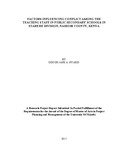| dc.description.abstract | The aim of the research was to establish the organizational, relational and external factors
influencing conflict among the teaching staff in public secondary schools in Starehe
Division of Nairobi County. The study also considered how the factors influencing conflict
interact and the conflict alleviation approaches available in the public secondary schools.
The study employed quantitative research designs to conduct the study. Data was collected
using questionnaire as the instrument. The study used Starehe Division through purposive
sampling to represent Nairobi County. The Division had a total of 11 public secondary
schools out of which 6 were sampled using the stratified random sampling to ensure that all
the categories of schools were represented. Random sampling was used further to sample
169 out of the 306 teachers and school administrators currently teaching in Starehe Division
based on the sampling table by Robert and Morgan (1970).The questionnaire was piloted in
two schools which were not part of the randomly selected schools in the division. Reliability
of the Pearson’s product moment formula for the test-retest was employed to compute the
correlation coefficient (r) and necessary adjustments done before embarking on data
collection. The data collected was coded and entered into the computer for analysis using
statistical package for social sciences (SPSS, Version 21) and analysis presented using
descriptive statistics of percentages and frequencies. Pearson Correlation was used to test
relationships between and among factors of conflict Results of the study indicated that
organizational and relational conflicts were high in public secondary schools in Starehe
Division. The majority of the schools (92%) did not have conflict resolution policies and the
few available were not applied effectively. Among the organizational factors ranked by
percentages, the majority (57.2%) agreed that conflicting needs was the main organizational
factor influencing conflict followed by conflicting roles and pressures (52.9%) and finally
unpredictable policies at 49.3%. However, the differences between the three factors were
not significant. Among the relational factors as ranked by percentages, the majority (55.1%)
indicated that conflicting goals and values were the main factor influencing conflict
followed by conflicting styles (54.3%) and finally conflicting perceptions at 42.8%. The
main role of the union was not recognized as the majority of the respondents (56.5%) were
not sure of the role of the union in handling of conflict in schools. This was unlike the role
of the employer and the parents which were negatively rated in all cases. There was a high
positive correlation between the organizational and the relational factors as the two are
mutually dependent on each other, hence the need to always tackle both as they arise.
Among the recommendations was that the school administration should involve the all
school stakeholders more in conflict identification and management in the public secondary
schools to allow for the creation of positive relationships among the teachers and between
the teachers the external stakeholders; Further research should also be done to cover all
public and private secondary schools as the influences of conflict tend to vary from situation
to situation and may need in depth analysis in order to get more information. | en_US |

